
Project Gutenberg's Motorland Magazine, September-October, 1955, by Anonymous This eBook is for the use of anyone anywhere at no cost and with almost no restrictions whatsoever. You may copy it, give it away or re-use it under the terms of the Project Gutenberg License included with this eBook or online at www.gutenberg.org/license Title: Motorland Magazine, September-October, 1955 Author: Anonymous Release Date: August 22, 2020 [EBook #63005] Language: English Character set encoding: UTF-8 *** START OF THIS PROJECT GUTENBERG EBOOK MOTORLAND MAGAZINE *** Produced by Stephen Hutcheson and the Online Distributed Proofreading Team at https://www.pgdp.net

AFEA WFEA
INFORMATION ON
MONTEREY PENINSULA
PLACE OF THE ANNUAL MEETING
AUGUST 26-29, 1956

Rocky headland, “The Pinnacle”, at Point Lobos State Park, and the gaunt branches of a Monterey Cypress.
MOTORLAND
SEPTEMBER-OCTOBER, 1955 · Vol. LXXVI No. 5

Published bi-monthly by
CALIFORNIA STATE AUTOMOBILE ASSOCIATION
Officers of the California State Automobile Association
| Edward H. Peterson | President |
| A. E. Strong | Vice-President |
| Fred J. Oehler | Vice-President |
| Irving H. Kahn | Treasurer |
| Edwin S. Moore | |
| Secretary and General Manager | |
| Board of Directors | |
| Reginald H. Biggs | Walnut Creek |
| H. J. Brunnier | San Francisco |
| S. V. Christierson | Salinas |
| G. A. Filice | Berkeley |
| Dr. Charles B. Griggs | Oroville |
| Irving H. Kahn | San Francisco |
| Joseph R. Knowland | Oakland |
| J. J. Krohn | Arcata |
| Harold J. McCurry | Sacramento |
| Joseph F. McDonald | Reno, Nevada |
| Fred J. Oehler | San Jose |
| J. E. O’Neill | Fresno |
| Obert Pedersen | Santa Rosa |
| Edward H. Peterson | San Francisco |
| Clyde W. Rann | Redding |
| J. B. Rice | San Rafael |
| Prentiss A. Rowe | San Francisco |
| Porter Sesnon | San Mateo |
| A. E. Strong | Santa Cruz |
| Norman S. West | Modesto |
| Honorary Life Director | |
| E. B. Degolia | San Francisco |
| Inter-Insurance Bureau | |
| Executive Committee | |
| Reginald H. Biggs | |
| H. J. Brunnier | |
| Irving H. Kahn | |
| Fred J. Oehler | |
| J. E. O’Neill | |
| Edward H. Peterson | |
| Porter Sesnon | |
| W. Foster Stewart | Manager and Attorney-in-Fact |
Entered as second class matter at the Post Office at San Francisco, California, under the act of March 3, 1879. Trade Mark registered October 25, 1911. Subscription, $2.00 per year; single copy, 50 cents. Office of Publication and Editorial Office: 150 Van Ness Avenue, San Francisco 2, California. Editor and Manager, Wm. F. Kilcline; Associate Editors, Fred Hamann, John G. Holmgren, Samuel B. Wylie; Editorial Consultant, Arthur M. Johnson; Art Direction, Paul Q. Forster. Copyright 1955 by the California State Automobile Association.
The establishment of roadside rests and the construction of a bypass of the state parks on the Redwood Highway are two vital and important projects for California. Bills designed to accomplish these two worthwhile developments were introduced and passed by both houses of the Legislature, but they failed to receive executive approval.
In rejecting the bills, the Governor felt that they represented only a part of an over-all development of a future state parks program. As the head of this greatest of touring and motoring states, he fully recognizes the merit of roadside rests and the Redwood Highway bypass and indicates that they will receive further consideration during the budget session of the Legislature in 1956.
The touring business is a billion dollar industry in California. It has become an integral and even necessary part of our state’s economy. Whatever money is spent to foster and develop our tourist trade is an investment that will inevitably bring rich returns.
If California wishes to maintain its lead in the touring world, roadside rests are a “must.” All but five of the 48 states already have roadside rest programs. These carefully-picked, off-highway spots are places where motorists may make stops in safety. They also encourage motorists to keep highways clean by providing free facilities for eating lunches and disposing of litter.
Building a bypass highway around the redwood groves in Humboldt County is imperative. If a four-lane highway were plowed through them, along the path of the present route, there would be a shameful destruction of these beautiful and awe-inspiring marvels of the botanic kingdom. Some groves would be virtually eliminated. However, a bypass development to preserve these great trees can’t be put off much longer. The present route carries an increasing burden of traffic and the need for an improved highway grows more urgent each day.
Undoubtedly these two important measures will receive favorable action during the Legislature’s budget session next year. In fact, California can’t afford to let them be delayed too long.
In few places do History and Tradition, Romance and the Wonders of Nature combine to offer so much to the visitor as in the region surrounding the Bay of Monterey.
In the north is Santa Cruz, with its famous beach and lovely gardens, and backed by the Santa Cruz Mountains with their redwoods. Southward are historic old Monterey and Carmel, the art colony which has now become a Mecca for sight-seers and vacationists. South, again, extends a road between the mountains and the sea which is one of California’s scenic marvels.
And as if all this were not enough, Nature has endowed the inland valleys with such soil and climate that agriculture flourishes on a tremendous scale.

Santa Cruz grew from the mission of the same name, founded in 1791, and the settlement of Branciforte, established six years later. It might have been any other community in pastoral California until the Gold Rush, but then the newcomers demanded vegetables, which the Santa Cruz area was able to supply, and lumber, for which the redwood forests in the nearby mountains were raided.
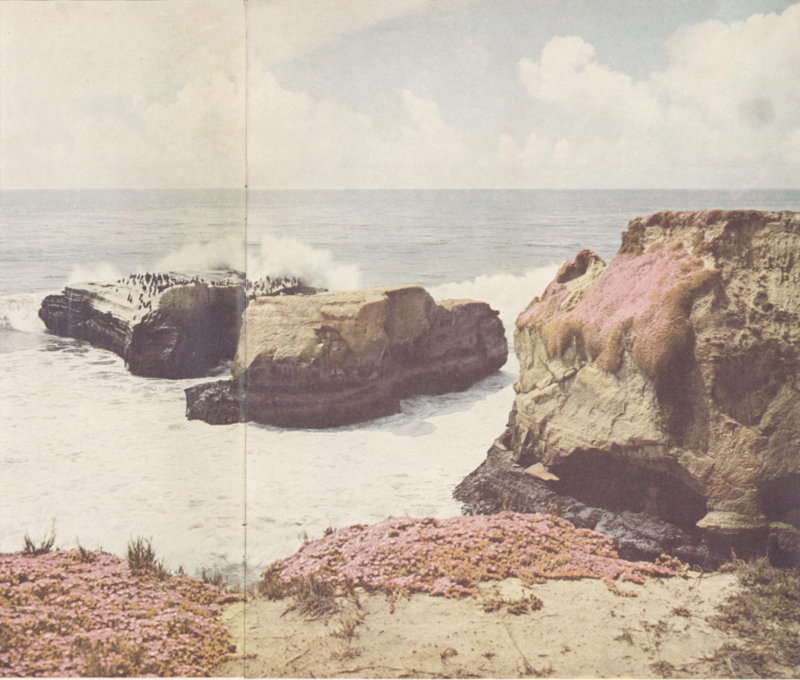
Surf and sea-fowl, cliffs and rocky islets, characterize Monterey and Santa Cruz areas. View above is from Lighthouse Point, Santa Cruz.
Even in the seventies, however, this was known as a resort region, where the nabobs from San Francisco came to take their ease and recuperate from the strains of their latest coups of high finance. It came into full stature with the building of its first beach casino in 1906. Though this promptly burned, it was as promptly replaced with the ornate structure the public sees today. This has been further improved and renovated in recent times, as has also the Coconut Grove dancing pavilion which is an outstanding beach feature. Beside the mile-long beach of white sand with its beautifully clear water there is an indoor salt-water plunge and a boardwalk which runs eastward to the San Lorenzo River. These, with a varied assortment of rides and concessions, drew 2,000,000 visitors last year and bid fair to excel that figure by a fifth this season.
The city has other claims to fame in that it is the scene of the annual Miss California contest and the terminus of a yearly yacht race from San Francisco.
In the Santa Cruz Art League Galleries is a life-size waxwork, “The Last Supper,” modeled on DaVinci’s famous painting of the same name. In four years it has been visited by more than 260,000 persons.
Blue and Peaceful or Bleak and Storming, the Ocean Wields a Never-Ending Influence Over the Region

Cormorants find Lone Sentinel Rock, off Seabright Beach, a favored resting place.
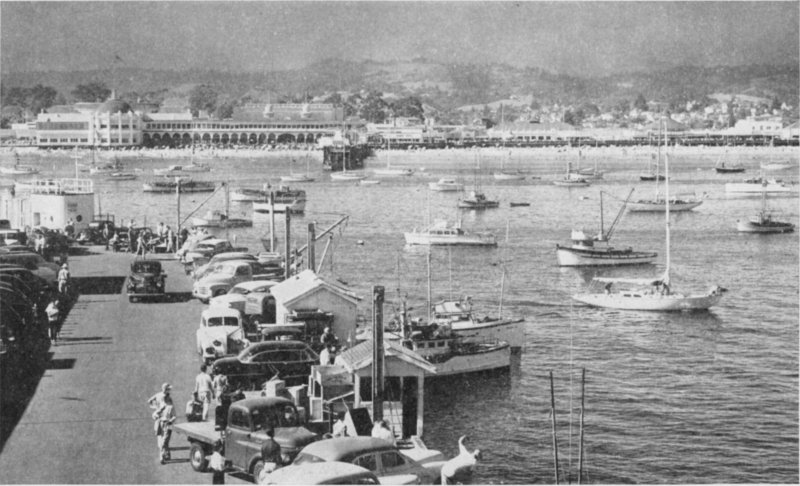
Pleasure craft by scores find anchorage beside Santa Cruz’ Municipal Wharf, where also fishing vessels moor and many an angler drops a line.
In the nearby mountains are the permanent convention sites of several religious groups, one of which includes 5 a building capable of seating 5,000 persons. These and other conventions rank virtually as an industry in Santa Cruz’ economy. But Santa Cruz is more than a resort or convention city. It is a city of flowers. The Spanish Garden at its city hall is beautiful. The drive north along the ocean front takes the visitor past bluffs which are ablaze with colorful succulents and flowers. In season, whole hillsides south of the city flame with yellow bush lupine. Some of these plants have trunks as thick through as a man’s leg.
PACIFIC OCEAN
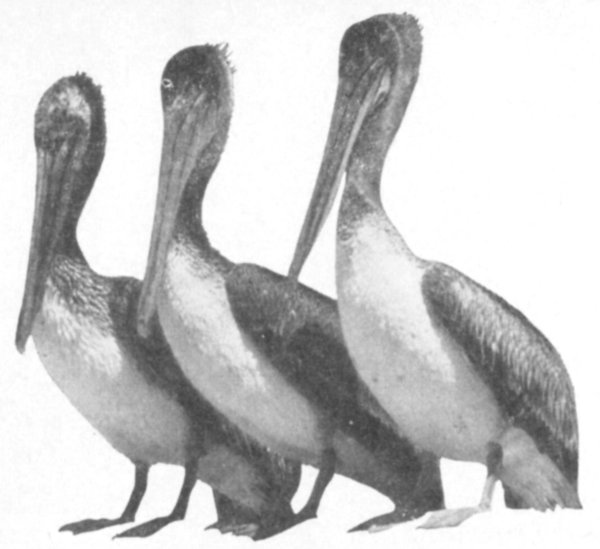
Pelicans may be seen on every wharf and pier, almost every rock, from Santa Cruz to Carmel. Wise looking old birds, aren’t they?
Bulbs, cut flowers and nursery stock are the biggest crop in the Santa Cruz area, though a vast quantity of strawberries is raised and the loganberry was developed in a Santa Cruz garden by James H. Logan, banker, attorney and superior judge, who crossed the wild blackberry with the Lawton berry to produce the delectable result. Brussels sprouts are another outstanding crop.
Santa Cruz also raises mushrooms, in old caves once used for aging wine and in newer concrete structures.
The largest bulb farms are at Capitola, shipping 3,500,000 tulip, lily, dahlia and begonia bulbs a year. As each of these in turn comes into bloom these farms offer a sight to be seen nowhere else. Championing the region’s claim to being the “Begonia Capital of the United States,” a festival is held each year on the waters of Soquel Creek, with thousands of blooms scattered over the water and colorful floating displays.
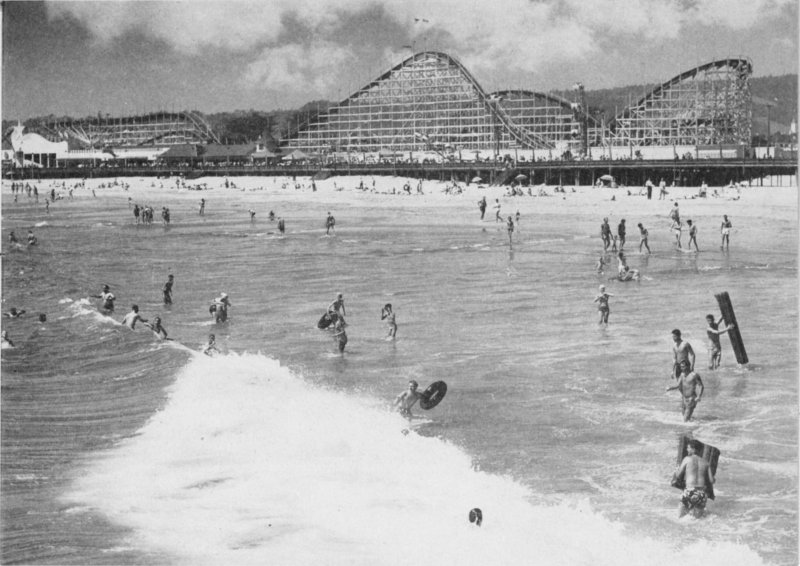
For more than 2,000,000 visitors a year, Santa Cruz means FUN—fun in the indigo-dark water, fun on the fine white beach, fun ashore.
San Lorenzo Canyon, which begins a bare stone’s throw from Santa Cruz, is full of summer homes and resorts, 6 including one famous inn where a mountain stream runs through the dining room.

This ancient span, moved from original site to DeLaveaga Park, in Santa Cruz, recalls times when horsepower was really horses.
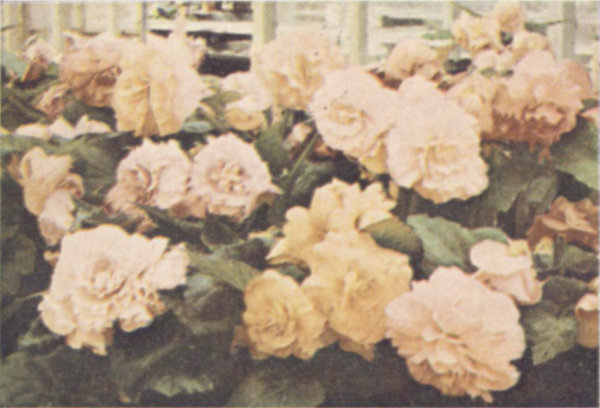
Color beyond description decks bulb farms near Capitola each autumn, well justifies the name “Begonia Capital of the World.”
Up this canyon, too, is the Henry Cowell Redwoods State Park, better known as “The Santa Cruz Big Trees.” The park comprises nearly 20,000 acres, but the “Big Trees” are a compact group, which may be seen in an easy walk of about a mile.
Farther north is Big Basin Redwoods Park, the oldest and largest of the State Park system, with many virgin growth trees and an interesting “Nature Lodge” which shows, besides flora and fauna of the park, the methods used in early day redwood lumbering.
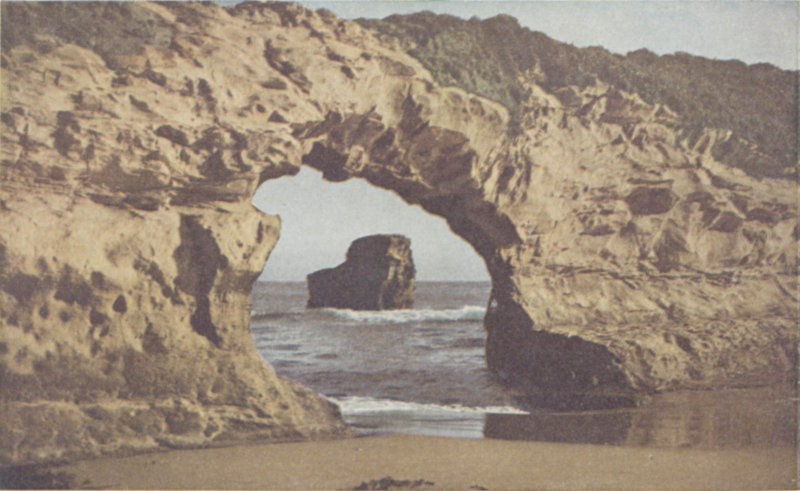
Wind and sea carve endlessly at the cliffs west of Santa Cruz. This graceful arch in Natural Bridges State Park is one of the results.
In the city of Santa Cruz itself is Natural Bridges State Park, a notable example of erosion, and along the coast in Santa Cruz County are six other state parks—Seacliff Beach, where a World War I concrete freighter is used for a fishing pier and a fine road parallels the cliffs; Sunset Beach, with a high lookout and picnic ground under twisted cypresses; Capitola Beach, where there is a 7 special pool for small fry; New Brighton Beach, Manresa Beach and Zmudowski Beach. At some of these campsites are available.
All through the mountains are interesting roads: the Empire Grade route from Santa Cruz through Bonnie Doon to Boulder Creek is particularly pointed out to visitors. In spring, so are the mountain apple orchards along the Valencia Creek route from Santa Cruz to Watsonville.
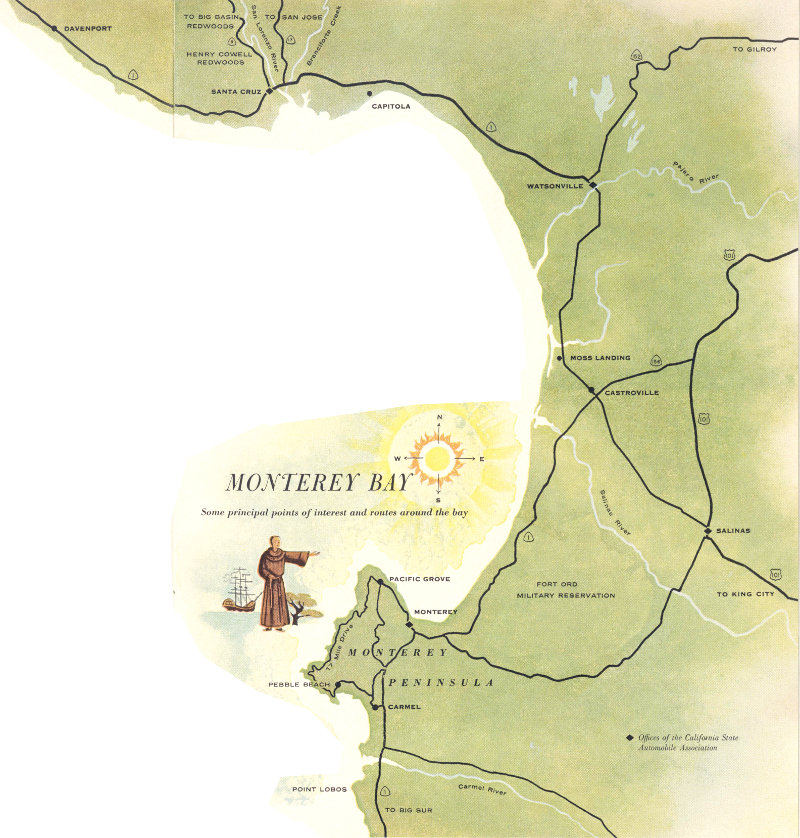
MONTEREY BAY
Some principal points of interest and routes around the bay
Highly scenic routes from the north to the Monterey Bay region are, first, the Skyline Drive from San Francisco, then down to the San Lorenzo Valley and on through its fine redwoods to Santa Cruz, and, second, the beautiful highway which follows the shoreline from San Francisco south. The main route over the mountains from Los Gatos to Santa Cruz is spectacular. The highway from Santa Cruz to Watsonville is a concrete ribbon between lovely rolling hills gay with color. On the Hecker Pass route from the Santa Clara Valley to Watsonville you can 8 see redwoods, the whole coast of Monterey Bay, and four charming little lakes. The Chittenden Pass route, used by railroad and highway, traverses a gorge of real scenic interest.

Big Basin Redwoods State Park, oldest and most popular of the state system, acts as host to more than 500,000 visitors a year.
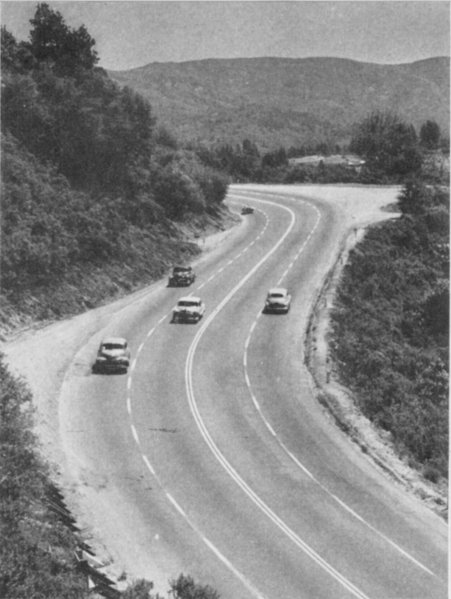
Main avenue of approach to Santa Cruz is this fine highway from Los Gatos. Curving gently through the Santa Cruz Mountains, it brings to view a wealth of lovely scenes. Under construction is a by-pass which will take its traffic off Los Gatos’ streets.
Santa Cruz has its face to the future. Monterey, at the other end of Monterey Bay, never forgets that it was the place where history began for this region.
It was in what is now the city of Monterey that Portola, first governor of California, and Father Junipero Serra landed in 1770. Under an oak tree near the shore the good father held a service and founded a mission. A stone cross today marks the spot, though the mission was soon removed to its present site at the mouth of the Carmel Valley to be away from the presidio, or military post, which Portola set up. At this mission Father Serra made his headquarters and from it he supervised the building of the mission chain.
Under Spanish rule, presidio and mission were almost all the settlement but after Mexico had gained independence, adobe homes grew up in the hills, stores were built along the crooked streets and the Mexican government, less averse to foreign trade than the Spaniards, built a customs house. This still stands and, restored, houses a museum. It is one of five State Historical Monuments in the region, the others being the Serra landing place already mentioned: the Casa del Oro, which housed a store: the house where Robert Louis Stevenson lived for a few months late in 1879, and California’s First Theater, originally a sailors’ boarding house.
There are also standing more than a score of other structures erected in this Mexican era, including one built in 1835 by Thomas Oliver Larkin, first United States consul at Monterey, and Colton Hall, meeting place of the Constitutional Convention in 1849. This, like almost all the other remaining buildings, has been restored.
Monterey has laid out a scenic route leading directly to or near all of these historic structures, and also including several historic sites. Visitors may traverse this route merely by following an orange line painted on the street paving. At many points on it, special parking is reserved for them.
Whichever way you turn, there is something to be seen in this region. Just across from the Customs House is Fisherman’s Wharf, where the restaurants would feel unhappy if they had to serve you today fish that was caught as long ago as yesterday. Alongside it, the fishing fleet, decked in all the colors of the rainbow, rides at anchor. Farther along the beautiful ocean drive is the Hopkins Marine Institute, operated by Stanford University, and beyond that is Pacific Grove, with its beautiful marine park and beach at Lover’s Point and its famous Butterfly Trees.
Each October, thousands of Monarch butterflies migrate from Canada and Alaska to cluster on these pine trees in a small reservation known as Butterfly Park.
How the butterflies know which trees are “home” no one can explain, for they are hatched and pass through their chrysalis stage in the North. Indeed, in recent years 9 it appears they have become confused: the number now visiting the original trees is greatly reduced and many of them are frequenting other pines several blocks away.
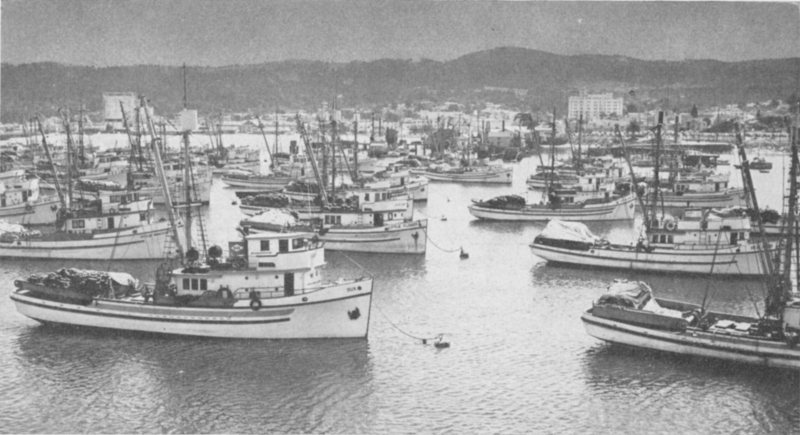
Home ports for several hundred fishing vessels are Monterey, Santa Cruz and Moss Landing. This is part of the fleet which bases at Monterey.
Santa Cruz Means Redwoods and Mountains, Fertile Fields and Fragrant Orchards, Long White Beaches, Fishing, Festivals and Fun for All
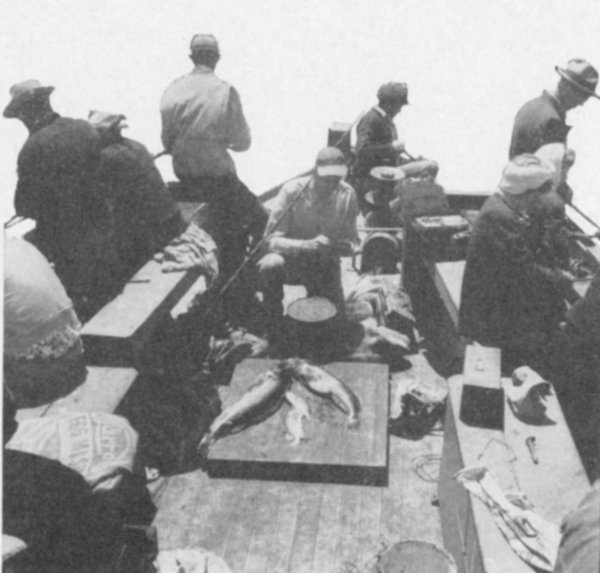
Party boats on which the land-lubber may embark for a day of deep-sea fishing are operated from Monterey and Santa Cruz.
Also not to be overlooked in Pacific Grove is an excellent Museum of Natural History. Its collection of Monterey County birds and its displays of marine life found in nearby waters are exceptionally complete. In Butterfly Park is another museum, though it is called a gallery, in which are displayed hundreds upon hundreds of butterflies, moths and other insects.
If, like most visitors to Monterey, you continue to follow the bay shore, where miles of wildflowers adorn the bluffs, you will come eventually to the Seventeen Mile Drive, which runs through a tremendous private preserve. On this, for most of the way, you travel with the fantastically blue ocean on one hand and truly marvelous dark green forest on the other. At times your route runs on low bluffs near the ocean, and again you are on rocky cliffs high above. Back among the trees, near the Pebble Beach area where the sports car races are held every year, you frequently see homes that are almost palaces.
On your way you pass Cypress Point, which is one of only two places in the world where the Monterey cypress is indigenous, and Midway Point, a rugged rocky spine jutting into the sea and bearing a single lone and twisted cypress, probably the most photographed tree in the world. Not far away is the Ghost Tree, another cypress whose whitened trunk and limbs seem like the bones and shroud of a fleeing wraith. Then your route leads past Del Monte Lodge, with its array of fashionable shops, and on through Pebble Beach, and thence to Carmel.
Carmel is unique, a “village” conceived by artists and now perhaps the home of more well known writers, 10 painters and other workers in the arts than any other community in the state. Carmel has no street numbers, no mail delivery, and you have to get permission from the town council before you may even cut down a tree on your own property.

In spring the apple blossoms whiten thousands of trees and spread their delicate fragrance over many a mile in the Watsonville area.
In Carmel the trucks in which garbage is collected are adorned with baskets of flowers. The street signs bear carved and painted decorations—a pine cone, a squirrel, a ship under full sail, or something else associated with the region. The shops are small but legion, many of them hidden away in courts and arcades which the non-resident is likely to pass unwittingly. Their stocks are fabulous—and not all of it expensive, either.
In between are quaint places to lodge, to lunch, to dine or take tea after the English manner. Of course there are conventional establishments, too, but somehow everything in Carmel seems to have just a little different flavor.
The town stands on an oak-and-pine-clad slope with a magnificent beach fronting on Carmel Bay at its foot. Along the shore is a lovely drive, on which are homes beyond the dreams of most folk. Back among the trees are others. The comfortable domiciles built by the original artist colony still exist, but they are a minority; Carmel has become a place to which the wealthy, as well as the well-to-do and the merely comfortable, come to spend their later years.
Carmel has an outdoor theater, a Bach Festival and an art gallery maintained by an artists’ co-operative. Its Church of the Wayfarer has a garden containing, it is said, every tree, shrub, herb and flower mentioned in the Bible. Other gardens, formal and informal, are everywhere. Once a year a number of the finest are thrown open for public inspection.
And then there is the Mission San Carlos de Borromeo, where Father Serra held sway. The present church is not the one he knew; it was not begun until nine years after his death in 1784. But under its sanctuary floor he, Padre Crespi, Padre Lasuen and another lie buried. The structure has many features distinctive from the usual mission architecture, among them its massive south tower, with outside staircase and Saracenic dome, and a star window. It is of sandstone and has a vaulted roof as it 11 did originally but in restoration the roof angle was made less sharp. Some of the original decoration may be seen in a small chapel to the left of the entrance. In a side chapel is a magnificent sarcophagus in marble and bronze, the work of Jo Mora.
A few miles south of the old mission is one of Nature’s wonderlands—Point Lobos Reserve State Park. Here stands the second native grove of Monterey Cypress, and here the ocean batters ceaselessly against spectacular rocky points which rise precipitously to make fjord-like coves. In these deep, sharp, inlets the blue water boils into furious bursts of white foam and spray, forming always-changing pictures of incomparable beauty.
Lush Valleys of the Salinas and Pajaro Rivers Rich in Pastoral Charm, Even Richer in Their Vast Yields of Lettuce, Apples, Berries, Livestock

Lettuce, famed “green gold” of the Salinas region, stretches in row after row for miles along the highways through the valley.
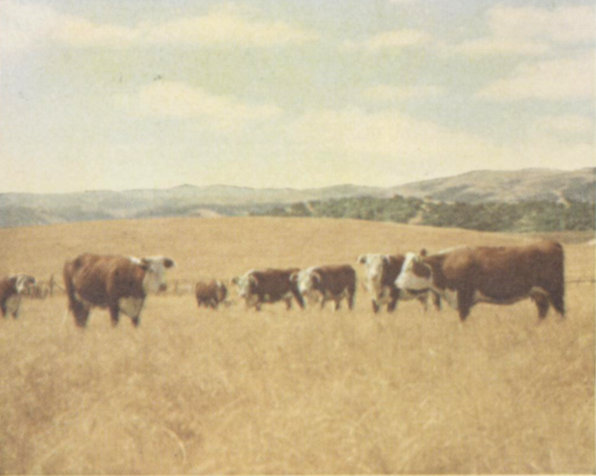
Beef cattle fatten on green hills and pasture lands in southern Monterey County, famed stock-raising area since mission times.
Offshore is a group of rocks haunted by both California and Steller sea lions, an island much used by seafowl and naturally named “Bird Island,” and a roiling, turbulent channel appropriately called “The Devil’s Cauldron” which is a favorite spot of the sea otter. These strange creatures were long thought to have been hunted to extinction but about 30 of them appeared in 1938 off Bixby Creek, 12 miles south of Point Lobos, and there are now believed to be almost 100 in the group. Some ardent pursuers of wild life are already asserting that the otter have now increased to such an extent that the “crop” should be “harvested”—a policy which could easily result in extinguishing the species.
A mile below Point Lobos is Carmel Highlands, an area of rich estates and fine homes, some of them set on the very edge of the continent. The James house, in this area, has been called the most beautiful residence in the United States. And the gardens hereabout are a thing to marvel at.
Beyond “the Highlands” runs a real road of romance, a motor highway carved from the seaward face of the Santa Lucia mountains. Most of the distance to its junction 12 with other routes at San Luis Obispo there is nothing between this road and the blue, blue sea but the cliffs. Above it, on the east, tower the mountains. It is no road for the man in a hurry, but for one who loves Nature it is glorious.

South from Carmel, in the trees or on the cliffs—sometimes almost built out over the ocean—are some of the most beautiful homes in America.
This is wildflower country. Within a 20-mile stretch you may see, in season, wild roses, primroses, California poppies, yellow lupine, wild mustard spreading over fields like a froth of foamy yellow, great bushes of blue lupine marching up rocky hillsides, almost cliffs: Queen Anne’s lace, succulents of many colors, and sometimes succulents which are not in bloom but whose foliage has turned a rich, dark red; Indian paint brush—all these abundant, in masses easy to see and recognize as you roll along. A naturalist could find many more.
The Spaniards would have come by this route if they could, but the mountains were too rugged, there was no path between sea and cliffs, and so they were forced inland. That this road was ever constructed was largely due to the efforts of Dr. John Roberts of Monterey, who used to ride horseback on calls to remote and isolated ranches up the canyons. It was almost 20 years in building.
South along this road from Point Lobos, beyond Garrapata Creek and Rocky Creek and Bixby Creek, past the light house at Point Sur and inland a few miles, is Pfeiffer-Big Sur State Park, a redwood park which is the entrance to 250,000 acres of wilderness area in the adjacent Los Padres National Forest. These redwoods are almost the most southerly of all: the actual southernmost ones are on Mill Creek, some 25 miles farther along the road.
And so to Watsonville. Watsonville exists because in 1852 one John H. Watson decided that the location was suitable for a town and, with another man, forthwith laid out one. Watsonville is strictly business. Even before Watson’s time, the Amestis, Castros, Vallejos and other Spanish pioneer families were busily raising grain and potatoes here. California’s great lettuce industry got its start in the Watsonville region and today it is a busy center for the raising and processing of lettuce, berries, beans, brussels sprouts, and many, many apples.
The traveler passing through Watsonville sees only a rather busy main street, plaza and business section, but only a little way to one side is an area where quick-freezing plants, ice plants, warehouses and lettuce-chilling works cover block after block, with switch engines busily shifting empty cars to be loaded and loaded cars to be made into trains and headed east.
Some eight miles south of Watsonville is Moss Landing, a port for vessels of moderate draft, from which the grain crops of the region once were shipped. Now it is the home of a picturesque fishing fleet and the scene of one of the largest steam-electric plants in the West. This giant, which the public may visit by obtaining a permit, produces 771,000 horsepower. Its eight boilers are each as high as a ten-story building and, the better to withstand any possible earthquake, are suspended in steel towers more massive than many bridge piers. Operators in the control room use television to watch the leaping flames inside the boilers and to supervise change-overs from natural gas to fuel oil when required. Steam pressure is an incredible—except to engineers—1,405 pounds per square inch in one section of the plant and 1,510 pounds in another.
Scenes and Structures on Unique “Path of History” in Monterey Bring Memories of the Days When California Was Young
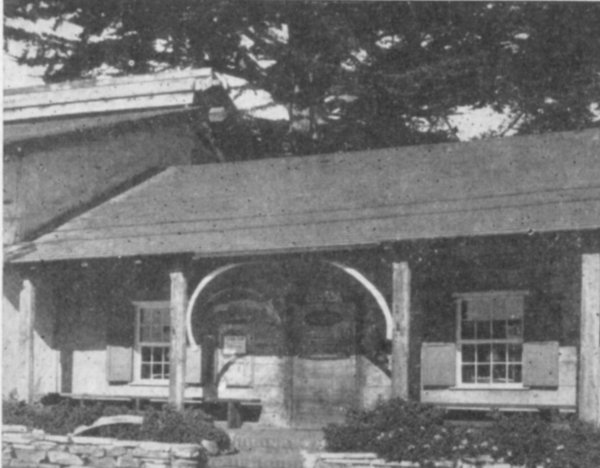
The first building in California in which a stage performance was given for an admission fee. Pacific and Scott Sts., Monterey.
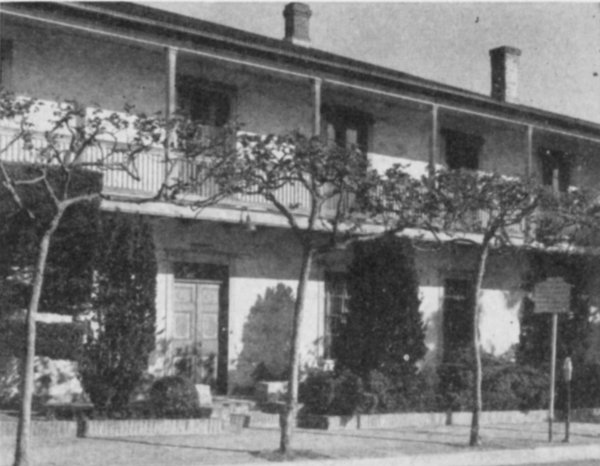
The Casa Amesti, on Monterey’s Path of History. Built early in Mexican era by Jose Amesti as a wedding gift to his daughter.
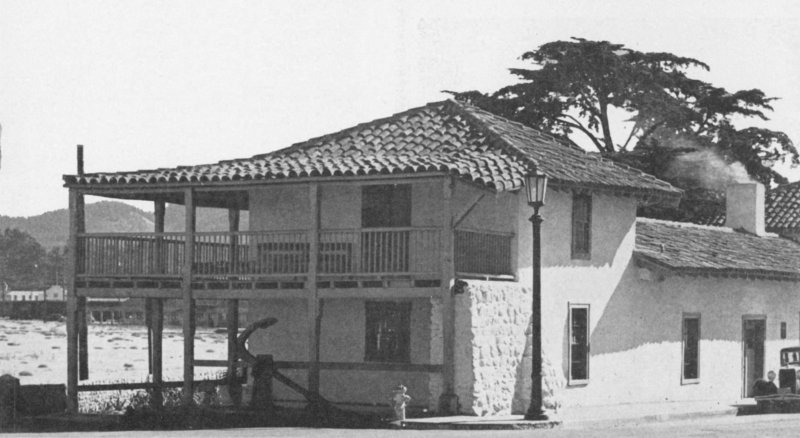
The old Customs House at Monterey. Here Commodore John Drake Sloat, on July 7, 1846, raised the American flag and claimed for the United States the entire West, all of which was then known under the name of California.
Between here and Monterey you may drive for miles between fields laid out in neat rows of thistly artichoke 14 plants. Castroville calls itself “The Artichoke Center of the World,” and with reason, for the annual production from this area is more than 1,300,000 boxes.
Natural Wonders and the Works of Man Combine to Create a Region of Tremendous Beauty and Wide Appeal to Students, Vacationers, and the Motorist Seeking Something New

Wildflowers in vast profusion and a galaxy of colors line the cliffs along the bayshore at picturesque old Pacific Grove.
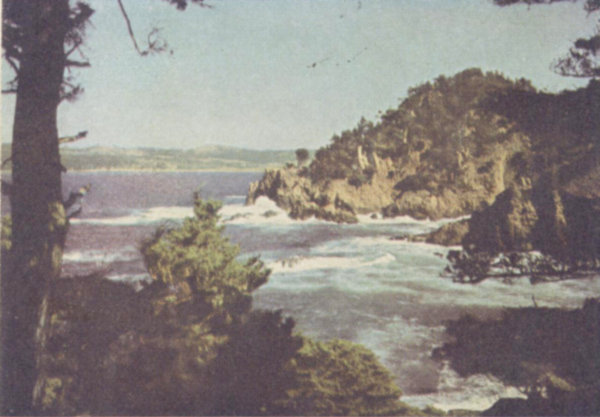
High rocky spines, spare gnarled trees, an ever-pounding surf and blue water are typical of shoreline at Point Lobos State Park.
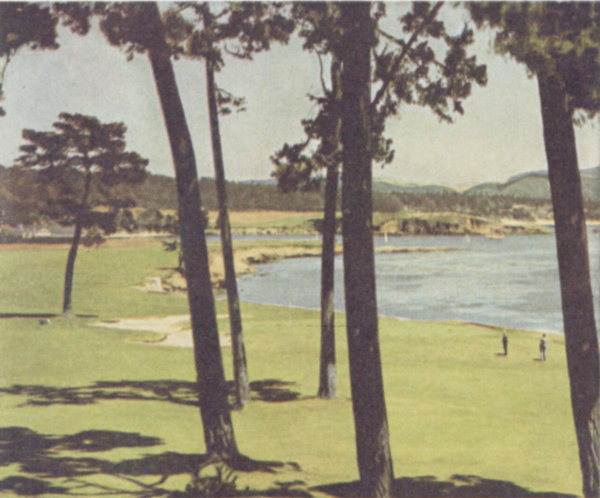
This is Pebble Beach, asserted by many to be the finest of all golf courses. Finals of the Bing Crosby Open are played here.
It is inland, however, in the great valley of the Salinas, that agriculture really hits its stride and while production in Watsonville’s Pajaro Valley is tremendous, that which centers in the Salinas area is even greater.
In the beginning Salinas was a center for livestock raising. Then overtones of agriculture were added as potatoes began to be raised thereabout. Later, sugar beets came in and the largest beet sugar refinery in the United States was built a few miles west of the city. Today, lettuce is the big item—two to three crops a year, worth more than $40,000,000.
Production on most of the larger ranches is on virtually an assembly line basis. Long machines, drawn by tractors, span 18 rows of the ripe lettuce. On a platform ride the packers, usually eight. Ahead of the machine walk cutters, one for each row, who cut the crisp green heads. Behind the machines are other workers who place the heads on a table before the packers. These packers place the heads in cartons which pass on to a worker who closes them, and another who staples the closure tight. The whole work proceeds so rapidly that a special worker is required merely to unfold cartons.
Trucks, each of which holds exactly half a carload, follow the picking machine and as the pallets on each truck are piled to the proper height with cartons of lettuce, that truck departs for a cooling plant where, under intense vacuum, the lettuce is cooled from the temperature of the hot field to a point just above freezing in a matter of only 18 to 20 minutes. Then it goes into pre-iced refrigerator cars, with the cartons still on the original pallets, and presently is on its way to market.
The old methods, by which lettuce was hauled to packing sheds for trimming, packing and icing, are now all but superseded and firms with tremendous investments in ice plants are wondering what to do with them, for when it was necessary to ice each crate of lettuce Salinas produced more ice than New York City.
Besides the lettuce which has given it the name “Salad Bowl of the World,” the Salinas Valley also produces more than $6,000,000 worth of dry beans, $12,000,000 worth of carrots, $5,500,000 worth of celery and quantities 15 of truck crops every year. The sugar beet crop runs to almost $7,000,000 a year.
In spite of its agricultural importance, however, Salinas still thinks of itself in terms of the old stock-raising days. The annual Salinas California Rodeo was started in 1911 to perpetuate the sports and traditions of the Old West. Membership on the 50-man board which controls this four-day event is a coveted honor. In this fast, dramatic, colorful spectacle, competition is of world championship caliber, prizes amount to approximately $50,000 and every effort is made to see that the stock is capable of bringing out the best in each competitor. “Salinas,” said one rodeo rider, “is where they separate the men from the boys.”
Yet, while agriculture and stock raising overshadow them, this region, too, has its recreation features. Paraiso Hot Springs and Tassajara Hot Springs are well known resorts. The padres and, before them, the Indians, made much use of the Paraiso Springs.
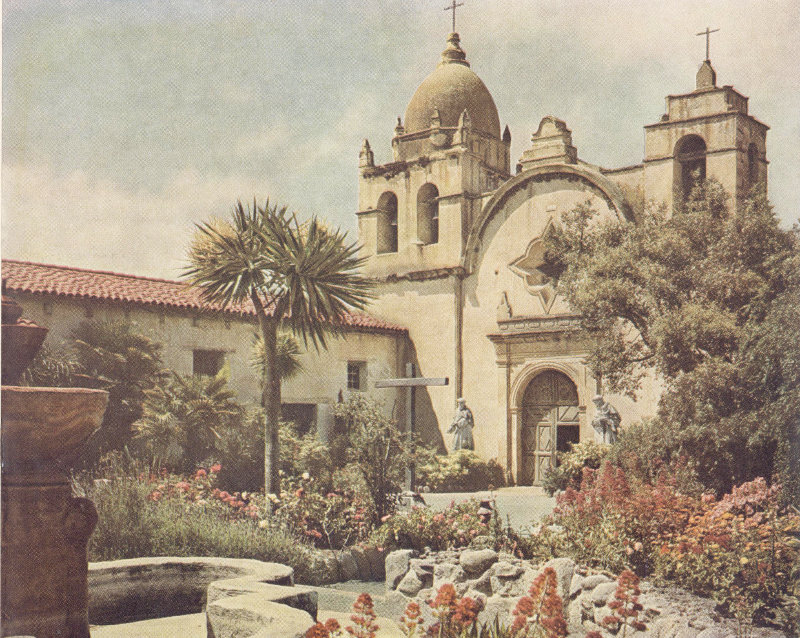
Mission San Carlos de Borromeo, at Carmel, is often called the most beautiful of all the missions. Its Saracenic tower is distinctive.
Like all the other sections traversed by the route of the padres, the Salinas Valley had its missions—Mission de Nuestra Senora de la Soledad, near the town of Soledad, and Mission San Antonio de Padua, near Jolon. Both fell completely into ruins but now are being restored. Only a beginning has been made at Soledad, but San Antonio has been largely rebuilt by the Franciscan Fathers and is in use as a training school for young brothers. It is a “working” mission—that is, not only a place for worship but a place where industry is carried on, as it used to be at the original mission, shoemaking, carpentry, book binding, the making of adobe brick and tile for the 16 rebuilding of the two wings which are still to be reconstructed, and all the maintenance work.
In addition to agriculture, food processing, and the activities dependent upon the sight-seers and pleasure-seekers, the economy of this region also derives considerable support from industry. It digs and processes sand for making glass and for other purposes. Salt and refractories are manufactured. Lumbering continues on privately-owned lands in the Santa Cruz mountains, with processing at Santa Cruz. Near Santa Cruz is one of the largest cement production plants in America, if not the world.
There are small-scale textile operations and a saddle leather plant in Santa Cruz, which city is also intensely proud of its new chewing gum plant. There are several seed farms producing flower seeds—a pretty sight in summer—and more producing field crop seed. There are busy commercial fishing fleets.
Stock-raising, with King City as an important center, brings the region more than $3,500,000 every year and dairying almost as much again.
Oil was discovered near San Ardo about eight years ago and production from this field, which has 480 active wells, holds steady at 30,000 barrels a day.
Mountains Marching to the Sea, Red Tiles Amid the Green of Cypress, White Clouds, Bare Cliffs and Crashing Surf—These Spell Enchantment

Highway One crosses this graceful span, whose arch rises 260 feet above Bixby Creek, on its way southward beside the ocean.
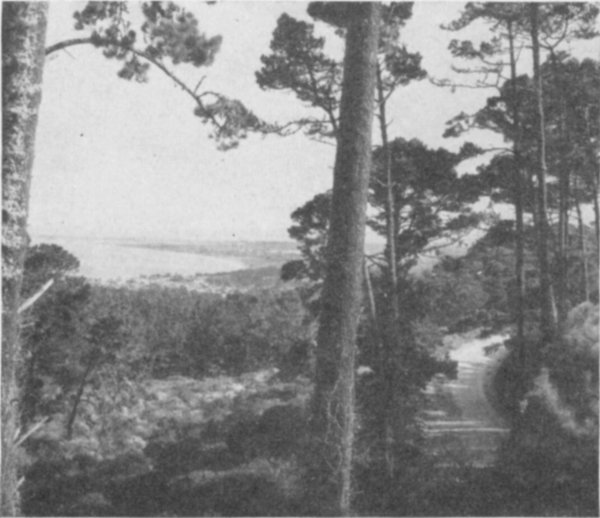
The Monterey Peninsula’s Seventeen Mile Drive is world-known for its beauty and variety. Above, a distant glimpse of Monterey.
Also important economically are the many military installations. The vast Hunter Liggett Military Reservation has headquarters near Jolon. At Fort Ord, a few miles north of Monterey, 30,000 to 35,000 military personnel and about 2,000 civilian employees are on duty. The once-famed Del Monte Hotel at Monterey has become a postgraduate school for naval engineering officers, with a faculty and student body totalling about 2,000. The Presidio of Monterey, established so long ago by Portola, is now an army school where some 400 specialists instruct about 2,000 students in one or another of 26 languages.
Of late years the construction industry has been very important, for cities all through Monterey and Santa Cruz Counties are growing so rapidly they are fairly bursting at the seams. At Salinas, residential development has extended far north of the Rodeo Grounds, which once were out in the country. Outside the city limits to the east is another development, called Alisal, almost equal in size to the residential area of Salinas itself. And there are several smaller subdivisions. At Monterey new subdivisions and communities, some very beautiful, extend far to the north and many fine old trees are being taken from properties along the Carmel Road to make room for more homes. Carmel has overflowed into Carmel Valley. Santa Cruz is adding residential construction at a rate of about $3,000,000 annually. Watsonville has grown more than 20 per cent since 1950.
Busy as it may be, however, it is all a friendly, hospitable country. Nowhere will you find people too hurried to bid you welcome and to do what they can to make your stay enjoyable.
—Written for Motorland by D. R. Lane.
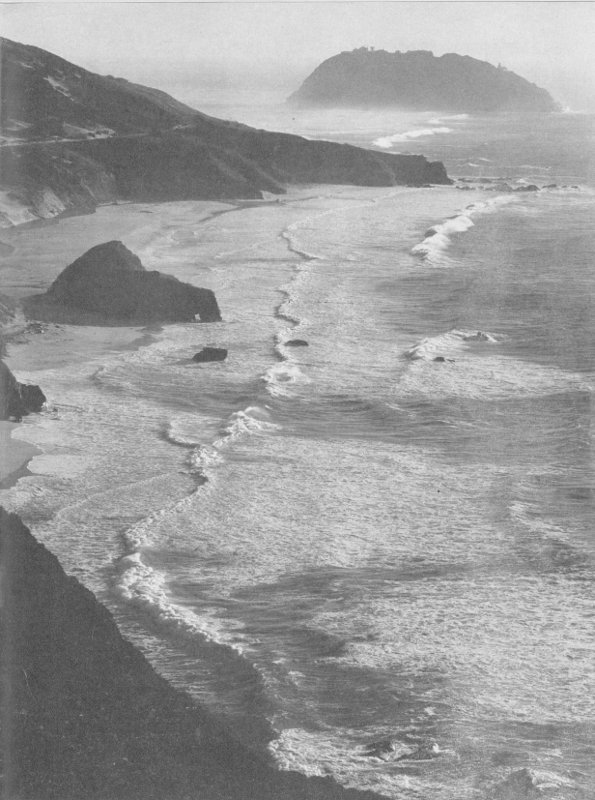
Along the coastline south of Carmel, the highway is literally hewn from the cliffs. “Island” above is really Point Sur, made famous by Robinson Jeffers in his “The Women of Point Sur.”
You may go through life without being in a traffic accident, or you may be involved in a traffic mishap and escape injury. But the statistics are not in your favor. You may be unfortunate enough to become a “statistic” in police or hospital records.
In these days of heavy traffic, even the most careful driver may be involved in an accident; and police and hospital records show that traffic crashes today result in more serious personal injuries than ever before.
That is why the California State Automobile Association has added extra value to CSAA membership, and is now issuing a Certificate of Personal Accident Insurance providing greater protection to members than heretofore. As in the past, this Personal Accident Insurance is included in your membership without extra charge. Beginning July 1 last year, the new certificates were issued to members as they renewed their memberships, and to new members as they were enrolled.

Continuous membership of three years or more maintains the maximum benefits provided by new Personal Accident Insurance.
This new Personal Accident coverage increases in value over the first three years of membership on condition that membership is continuous. The increased benefits remain in effect contingent on continued prompt renewal of membership over the years. For members with three or more years of consecutive membership, maximum coverage became effective for the current membership year upon issuance of the new insurance certificate.
The schedule of benefits in this added feature of continuous CSAA membership follows:
Payment to your beneficiary for accidental death involving an automobile is based on consecutive years of membership; first year, $500; second year, $1,000; third year and thereafter, $1,500.
Direct payments to you for other specific losses are also increased under this accumulative coverage.
Hospital benefits—$35 a week for a maximum of twelve consecutive weeks—are retained and all indemnities are subject to the standard provisions and limitations as specified in the Personal Accident Certificate.
Your membership must be continuous to make this new schedule of increased benefits effective for you; and your membership must be retained on a continuous basis to keep the increased benefits in effect. If membership is allowed to lapse, the benefits under the policy revert to the first year basis if membership is re-instated at a later date.
This accumulative plan of Personal Accident Insurance based on continuous membership was adopted by the Board of Directors, not only to provide more adequate protection, but also to accord recognition to continuous membership support.
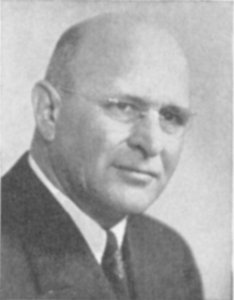
S. V. Christierson
Salinas
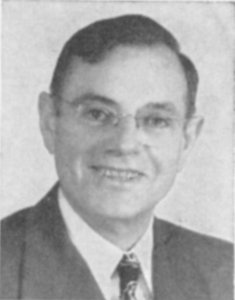
A. E. Strong
Santa Cruz
In the two counties “around Monterey Bay”—Santa Cruz and Monterey—there are four offices of the California State Automobile Association. They are strategically located in four main cities at focal points of the area’s network of highways to provide best service to the large membership in the two counties as well as the continuous flow of visiting members into this noted vacation and tourist region. These offices and their district managers are:
Santa Cruz, with a branch office in Watsonville, C. E. White; Salinas, J. E. Foust; and Monterey, Melvin R. Tuttle.
Two members of the Association’s Board of Directors represent this region. They are:
A. E. Strong of Santa Cruz, a vice-president of the CSAA; and S. V. Christierson of Salinas, civic leader and business executive.
The southern San Mateo County office of the California State Automobile Association has been moved to new and larger quarters at 1500 Laurel Avenue in San Carlos. This location is in the Laurel Theater Building, corner of White Oak and Laurel avenues, one block west of El Camino Real. The new office provides more adequate service facilities for the growing membership in this district than was available at the former location in Redwood City.
IT’S THE LAW
Making Turns Properly On Red Traffic Light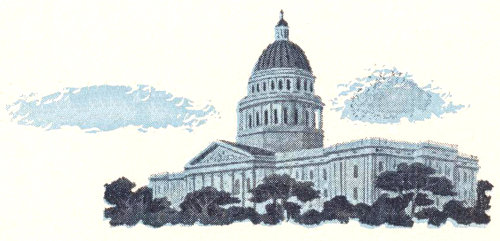
Right turns permitted against a red light must always be made after stopping and under certain conditions. It is timely to review these legal provisions in view of the new California law, effective September 7, governing the procedure of making left turns on a red light from a one-way street into another one-way street.
To make a right turn on a red light, the driver should come to a halt at the intersection as close as practicable to the right-hand curb. yielding the right of way to pedestrians and other traffic proceeding as directed by the stop-and-go signal. As soon as the way is clear, then the right turn may be made.
However, the law permits local authorities to prohibit such right turns on a red light in central business districts. Also, local officials may prohibit right turns on a red light outside the downtown area at any intersection under their jurisdiction if a sign is erected at the corner notifying the motorist to that effect.
On making a left turn against a red light from a one-way street into another one-way street, the driver should come to a halt at the intersection as close as practicable to the left-hand curb. When certain there will be no conflict with foot or vehicle traffic, the driver may proceed to make the turn.
Important new motor vehicle laws were passed by the 1955 California Legislature. Equally important changes and clarifications were made in many old laws.
Knowledge of these new regulations and revisions of the Vehicle Code is naturally vital to you as a motor vehicle owner and operator.
Several centuries ago a wise thinker, Thomas More, wrote:
“All laws are promulgated for this end: that every man may know his duty, and therefore the plainest and most obvious sense of the words is that which must be put on them.”
That advice is heeded in this article interpreting for you the new regulations and code revisions. The interpretations are actually summaries stated in everyday, non-legal language to make for easy reading and quick understanding of the essential elements.
September 7 is the effective date of these new laws, except for a few urgency measures which were put into effect immediately upon approval by the Governor.
The present California highway user tax rates will remain in effect until December 31, 1959, thus assuring the continuation of the state’s accelerated highway modernization program adopted in 1953. This new law carried an urgency clause and became effective January 22.
It is now provided in the Vehicle Code as well as in the Health and Safety Code that it is unlawful to dispose of any garbage, refuse or litter upon any highway or its right of way.
Driving under the influence of liquor is a misdemeanor. The penalty for a first conviction of such a misdemeanor shall be automatically increased to that of a second conviction, if the driver already has been previously convicted of a felony for driving while drunk.
Revocation of the driving privileges of juvenile offenders is mandatory upon conviction of certain serious offenses. Revocation or suspension shall also be imposed upon recommendation by the juvenile court judge for convictions of less serious offenses. The length of the terms of revocation or suspension shall be specified.
Local authorities, as well as the State Department of Public Works, may restrict speed to 25 miles per hour because of snow conditions. Local authorities may also determine the maximum speed allowable on any bridge or structure, or in any tube or tunnel, constitutes part of a highway.
The speed limit on highways where persons are at work shall be a prima facie limit of 25 miles per hour instead of a fixed limit of 25 miles per hour.
The speed limit for heavy trucks and combinations is increased from 40 to 45 miles per hour.
The Vehicle Code provides that the registered owner of a motor vehicle is responsible for any parking violation involving the vehicle. That presumption, however, does not mean that the registered owner is further presumed to have violated any other provision of the law.
To pass a motor vehicle going less than 20 miles an hour on a grade, an overtaking vehicle must go at least 10 miles an hour faster. In addition, it must complete the passing movement within a quarter-mile distance.
Heavy trucks shall use only the lane to the immediate left of the right-hand lane when passing another vehicle on freeways and multiple-lane highways. Where passing on the right is permitted, trucks may do so.
A peace officer may remove an illegally parked motor vehicle to a garage or other place of safety.
U-turns are prohibited on the approaches to or in front of any fire station.
School Safety Patrol members may be stationed at intersections near as 20 well as adjacent to a school. The actual presence of a supervisory school employee is not necessary at a street crossing where a patrol is maintained.
Local authorities are authorized to close certain streets for use by colleges as well as high schools in giving automobile driving instructions.
School districts, under the Education Code, are allowed to conduct driver training classes on Saturdays.
It is unlawful to refuse to obey the directions of a fireman, whether a police officer is present or not, when he is protecting fire-fighting personnel and equipment.
Stops at an arterial stop sign are to be made at the limit line, if marked, even though there may be a crosswalk.
Emergency vehicles under certain conditions are permitted to go in a direction opposed to moving traffic on a one-way street or roadway.
Authorities may erect traffic control devices at the intersection of a highway and a private road or driveway if traffic conditions warrant.
License plates shall be mounted on a motor vehicle not less than 12 inches or more than 60 inches from the ground. They are also not to be covered with any material which decreases or impairs their legibility.
Registration and vehicle license fee reciprocity is granted to motor vehicles registered in other states pending the establishment of a California Reciprocity Commission. To prevent needless confusion and disruption in the interstate movement of vehicles and trade, this law carried an urgency clause and became effective April 14.
The program of quarterly registration of commercial vehicles is continued indefinitely.
Additional summaries of new motor vehicle laws and revisions of the Vehicle Code will be published in the next issue of Motorland.
Questions in endless variety are asked by members about California and Nevada history. Here are a few selected for their general interest, with answers from authoritative sources.
What was the background of Father Junipero Serra? He was a native of Majorca, and held the chair of philosophy at the university there when he was chosen to Christianize the Indians. Before coming to California he spent several years in Mexico, teaching in the College of San Fernando and attaining wide influence among the descendants of the Aztecs as a spiritual leader.
How many capitals has California had? Five—Monterey, San Jose, Vallejo, Benicia and Sacramento. Vallejo was capital twice, the first time in 1851-2 and again in 1853.
For whom is Truckee named? For one of Fremont’s Indian guides.
When was the old Bale Mill, near St. Helena, built? In 1846. However, the present 40 foot wheel is a replacement for the original much smaller one.
When was the Butterfield stage line established? In 1858. It ran from St. Louis to San Francisco, the longest stage line in the world.
Did the United States make any effort to acquire California prior to the war with Mexico? Yes. The United States offered to buy this province from Mexico in 1835.
Where was California’s first railroad? Between Sacramento and Folsom. It was opened on February 22, 1856.
What was the first American flag ship to sail into California waters? The Otter, out of Boston, entered the Bay of Monterey in 1796.
Was the hydraulic method of mining ever used outside the Mother Lode? Yes. The largest of all hydraulic workings, the La Grange mine, is near Weaverville, and the method has been used in many places outside of California.
Who first travelled the route across Nevada taken later by the Pony Express? This route is credited to a party of scouts sent from Salt Lake City in 1854 by Brigham Young. The route was followed later by the stages and is approximately that of the Lincoln Highway.

THE BABY PULLMAN, recently placed on the market in infant supply stores and some department stores, converts the back seat space of an automobile into a sleep or play area for infants. It is a padded platform suspended from the top of the front seat by two rubber-covered hooks and extending over the entire back seat when opened out. Two wings fold up to make a cozy padded crib, or one wing up leaves space for an adult to sit. This information was provided by The Herrmanns infant supply house, with stores in San Francisco, Berkeley and San Jose, where the Baby Pullman with pad retails for $15.93.
The California Division of Highways, says Assistant District Engineer H. S. Miles, has often cautioned drivers about horseplay while operating a motor vehicle. Recently a report was received by the Division on an accident that left no doubt as to which category it belonged. In response to the question, “Who in your opinion was at fault?” the driver wrote:
“The horse. As I was passing a group of horses on the roadway at a slow speed, two of them started to play and one backed up and sat down on the right front fender, causing a large dent.”
In Helena, Mont., a motorist took a bite out of a ripe plum while driving his car. Deciding he didn’t like it, he tossed it out of the car window.
Where do you think it landed? On the windshield of a Highway Patrolman. The motorist was fined for dumping garbage on the highway.
Montreal police swear this story is true. They received a telephone complaint from a man reporting the theft of his automobile’s steering wheel, dashboard, and brake, gas and clutch pedals. Police promised an immediate investigation.
A few moments later, however, the phone rang again. The same man said they needn’t bother. He had got into the back seat of his car by mistake and thought it was the front seat.
In Monroe, Wis., motorists picketed the city hall after officials decided to raise the fine for parking violations to one dollar.
It formerly was 10 cents.
In Toronto, a motorist hit a hole in a road and his car careened into a jewelry store window.
City authorities approved out-of-court settlements of $2,084 to the driver and $5,125 to the storekeeper. The hole was fixed for $7.
“Did you get his license number?” Oregon highway patrolmen asked a motorist after his car was struck by a hit-and-run driver.
“I sure did,” he replied. “I grabbed it as he drove away.”
He handed them the license plate.
Traffic-strangled motorists who tend to long for the “good old days” might well face the fact that things were no better then. In witness whereof we give you this late report on early road conditions by that peerless commentator, William Shakespeare, late of Stratford-on-Avon, England, as recently recorded in the New York Times Magazine:
“The horn, the horn, the lusty horn
Is not a thing to laugh to scorn.”
—As You Like It.
“These high wild hills and rough uneven ways
Draw out our miles and make them wearisome.”
—Richard II.
“Give me that mattock and the wrenching iron.”
—Romeo and Juliet.
“Oh, let him pass.”
—King Lear.
“A very dangerous flat.”
—The Merchant of Venice.
“He must needs go that the devil drives.”
—All’s Well That Ends Well.
“What, will the line stretch out to the crack of doom?”
—Macbeth.
“Traffic confound thee.”
—Macbeth.
“Smile, once more: turn thy wheel.”
—King Lear.
“Is this a holiday?”
—Julius Caesar.
“I can no further crawl, no further go.”
—A Midsummer Night’s Dream.
“I must shift.”
—The Merry Wives of Windsor.
“With what strict patience have I sat.”
—Love’s Labour’s Lost.
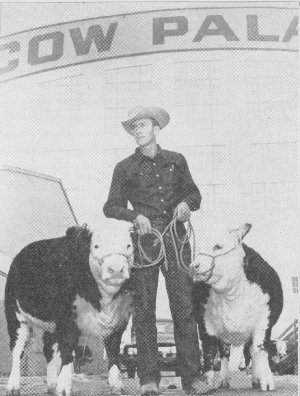
Herdsman Arnold Leonard of Stockton Ranch, Morgan Hill, leads Hereford heifers to the judging ring at Grand National.
The famed “Riders of the Andes,” elite cavalry troop of the Army of Chile, will be featured at the Grand National Livestock Exposition, Horse Show and Rodeo to be held in the San Francisco Cow Palace October 28 to November 6. Termed the world’s most spectacular group of horsemen, the 32 riders and horses will come to the Cow Palace as the result of two years of negotiations and a special decree of the Chilean Congress.
The National Hereford Show and Sale and the Pacific Coast Aberdeen-Angus Association Show and Sale are part of the livestock exposition, one of the nation’s “big six” shows.
New classes have been added to the national full-division horse show.
Top-ranking contestants of the United States and Canada will ride in the championship rodeo.
Regular performances will be held each of the ten evenings, starting at 8 o’clock, with matinees on the Saturdays and Sundays of October 29 and 30 and November 5 and 6, starting at 2 o’clock. Prices will range from $1.25 to $3.50.
An added performance this year will be a children’s matinee Friday, November 4, with a universal admission price of 50 cents.

Community Events in northern and central California and Nevada, scheduled for September and October, are listed below. Dates and data are subject to change. Information on events may be secured from any office of the Association.
SEPTEMBER
Sept. 1-11: Sacramento, California State Fair.
Sept. 2-4: Lakeport, Lake County Fair and Horse Show.
Sept. 3-4: Concord, Trail Ride and Show.
Sept. 3-5: Weed, Italian Carnival.
Sept. 3-5: McArthur, Inter-Mountain Fair, Horse Show and Rodeo.
Sept. 3-5: Nevada City, Pelton Wheel Diamond Jubilee.
Sept. 3-5: Pebble Beach, Labor Day Mercury Regatta, Stillwater Cove.
Sept. 3-5: Mariposa, Mariposa County Fair, Horse Show and Rodeo.
Sept. 3-5: Fort Bragg, Paul Bunyan Celebration.
Sept. 4-6: Tulelake, Tulelake-Butte Valley Fair.
Sept. 4-30: Santa Cruz, Statewide Watercolor Show.
Sept. 5: Stockton, Labor Day Parade.
Sept. 9: Santa Cruz, Admission Day Celebration.
Sept. 10-11: Truckee, Donner Lake Boat Races.
Sept. 12-18: San Jose, Santa Clara County Fair.
Sept. 14-18: Orland, Glenn County Fair and Rodeo.
Sept. 15: Lodi, Merchants Festival.
Sept. 15-18: Reno, Nevada, Washoe County Fair and Horse Show.
Sept. 15-18: San Francisco, Art Festival, Civic Auditorium.
Sept. 16-18: Auburn, District Fair and Horse Show.
Sept. 16-18: Kerman, Harvest Festival.
Sept. 16-18: Lodi, Grape Festival and National Wine Show.
Sept. 18: Walnut Creek, Folk Dance Festival, City Park.
Sept. 18: Napa, Junior Horse Show.
Sept. 18: Grass Valley, Barbecue and Gymkhana, Fair Grounds.
Sept. 18: Santa Rosa, Home Defense Day Parade.
Sept. 18-25: Saratoga, “Design at Home” Show, Villa Montalvo.
Sept. 22-24: Sanger, Grapebowl Festival.
Sept. 22-25: Madera, District Fair.
Sept. 22-25: Watsonville, Santa Cruz County Fair and Horse Show.
Sept. 22-25: Walnut Creek, Walnut Festival.
Sept. 23-25: Boonville, Mendocino County Fair and Apple Show. Horse Show and Rodeo.
Sept. 24-25: Sonoma, Valley of the Moon Vintage Festival.
Sept. 30-Oct. 2: Hollister, San Benito County Fair, Bolado Park.
Sept. 30-Oct. 9: Fresno, District Fair.
OCTOBER
Oct. 1: San Anselmo, Grape Festival, Sunny Hills.
Oct. 2: Chico, Horse Show.
Oct. 6-9: Pittsburg, Columbus Day Celebration.
Oct. 6-9: Turlock, Blue Ribbon Horse Show.
Oct. 13-16: Hanford, Kings County Fair and Rodeo.
Oct. 15: Woodland, Kiddie Pet Parade.
Oct. 15: Fowler, Fowler Fall Festival.
Oct. 28-30: Fresno, Cotton Folk Dance Festival, Memorial Auditorium.
Oct. 28-Nov. 6: San Francisco, Grand National Livestock Exposition, Horse Show and Rodeo. Cow Palace.
Oct. 29-30: San Rafael, Chrysanthemum Festival.
Oct. 29-Nov. 1: Ross, Chrysanthemum Festival.
Oct. 30: Fresno, Folk Dance. Memorial Auditorium.
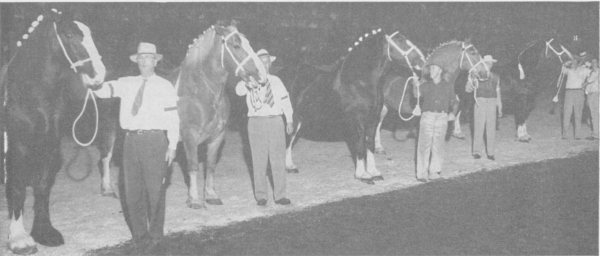
All the best of the Golden State—in agricultural products, livestock, industries, arts and crafts and entertainment features—will be on display at California’s State Fair, September 1 through 11 at Sacramento. There will be racing daily except Sundays, performances of the West’s oldest horse show in the evenings, and outdoor evening shows before the grandstand featuring the music of four outstanding American composers. Jeanette MacDonald, Margaret Whiting, Gorden McRae and Paul Whiteman will appear in these shows. Other entertainment features will include a Gayway with shows and rides, fireworks displays each night.
Berkeley has won a First Place Award in the 16th annual nationwide Pedestrian Protection Contest conducted by the American Automobile Association and sponsored in northern and central California and Nevada by the California State Automobile Association.
Berkeley received the award for its outstanding reduction in pedestrian deaths.
A Third Place Award went to San Leandro for its reduction of pedestrian fatalities and excellent pedestrian protection program.
Honorable Mention Awards were won by Sacramento and Richmond for the over-all excellence of their pedestrian protection programs.
Twenty cities were awarded Special Citations for various individual phases of their programs. They were:
Oakland, Alameda, Hayward, Stockton, Modesto, Monterey, Pacific Grove, Hanford, Tracy, Grass Valley, Sausalito, Ross, Manteca, Sebastopol, Fairfield, Red Bluff, Mount Shasta, Lakeport, Sutter Creek, and Reno, Nevada.
In addition to the above awards, 37 cities received Commendation Certificates for no pedestrian deaths during the year. They were:
Albany, Arcata, Belmont, Benicia, Burlingame, Carmel, Ceres, Chico, Concord, Daly City, Dunsmuir, Fairfax, Fowler, Hillsborough, Livermore, Lodi, Martinez, Menlo Park, Millbrae, Mill Valley, Oroville, Piedmont, Pittsburg, Roseville, Salinas, San Bruno, Sanger, San Rafael, Santa Clara, Susanville, Turlock, Ukiah, Vacaville, Willows, Yreka, and Elko and Sparks, Nevada.
The cities were judged in their respective population groups on the basis of pedestrian safety activities and fatality and injury records.
The nationwide contest spurs direct action in cities to insure greater pedestrian safety. The results are obvious; fatalities are declining despite growing motor vehicle registration. Before the contest began in 1939, as many as 15,500 pedestrians were killed a year, compared with the 7,900 killed in 1954.
Three-lane highways have a reputation as accident breeders—the middle lane often being referred to as the no-man’s land of the open road.
When using the middle lane of a three-lane highway for passing or turning during daylight hours, a sound driving technique is to turn on your headlights.
The lights serve as a warning to oncoming motorists not only that the middle lane is in use but also, and more important, that your car is approaching them in the middle lane.
Many motorists are confused by the general appearance of modern automobiles; and instances have actually occurred where drivers thought the other car in the middle lane was going in the same direction they were, until it was too late to avoid an accident.
There is no law requiring drivers to turn on their headlights under these circumstances, so don’t depend upon other drivers to have their lights on if they are in the middle lane. If yours are on, you are not only being courteous to other drivers, but also protecting yourself by alerting them to the fact that the middle lane is occupied by an approaching car. Also, remember to turn off your lights as you pull out of the middle lane.
Sign at entrance to a crossroads town: “Gas killed 3,029 people in this state last year—2 inhaled it; 27 put a match to it; 3,000 stepped on it.”
The difference between a straight-eight and the V-eight is just a matter of whether you like your troubles strung out down the line or all in one place.
Mrs. Jones (on telephone): “This time you really got yourself out on a limb!”
Mr. Jones: “Yes, dear. I drove off a cliff and was hung up all night in a tree.”
Modern automobiles are getting so free and easy to drive that we need power steering and power brakes to keep them under control.
Traffic Officer: “Your honor, I followed this man and he drove clear through town with an arm around this woman.”
Judge: “Something’s wrong. It’s not logical for a man to drive through town with his arm around his wife.”
Parking conditions have improved in some localities—you only have to climb over one car to get into your own.
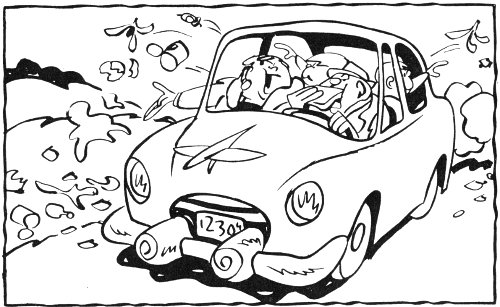
“With all the gadgets the automobile people put in their cars, it’s a wonder they wouldn’t
think of a garbage disposal unit.”
—Courtesy George Lichty and the Chicago Sun-Times Syndicate.
Recent changes in the list of Emergency Road Service contract stations serving members of the California State Automobile Association are reported below. Latest complete lists are available at all CSAA offices. Always carry a list in your car. Please mark these changes on your copy of current list.
Angels Camp, change in station: Wilmshurst Chevrolet Company; telephone, REdfield 6-2258. If no answer, call REdfield 6-2224. Succeeding Godell Motor Company.
Centerville, change in station: Central Chevrolet Company, 199 North Main Street; telephone, 8-8346; night, Sundays and holidays, call 8-8395. Succeeding Joe Adams.
Chester, new appointment: Chester Motors. State Route 36; telephone, 2654; night, Sundays and holidays, call 4693.
Cottonwood, new appointment: Grigsby Service. Highway 99 at 4th Street; telephone, Cottonwood 2161. After 10 p.m., call Anderson, EMerson 5-8583.
Kerman, change in station: Morgan’s Repair Shop, 360 South Madera Street; telephone, 6411; night, Sundays and holidays, call 5548, 5953 or 5103. Succeeding Sims Motor Company.
Kings Beach, Lake Tahoe, change in station: Ray & Mike’s Service, State Route 28; telephone, LIberty 6-2717. If no answer, call LIberty 6-3392. Succeeding Bailey’s Tahoe Vista Garage, Tahoe Vista.
If you move, please list your old address, as well as the new one, in the notice you send to the California State Automobile Association. With a membership roster of over 330,000, the old address is essential for any change. As for your copy of Motorland, it is not enough just to tell the Post Office, because they will not forward second class mail unless you pay extra postage. Also, a change of address notice given to the Post Office is kept on file for only a limited time.
| MAIN OFFICE | |
|---|---|
| SAN FRANCISCO | 150 Van Ness Ave. |
| Telephone MArket 1-2141 | |
| OTHER OFFICES | |
| AUBURN | 750 High St. |
| Telephone TUrner 5-1506 | |
| BERKELEY | 1849 University Ave. |
| Telephone THornwall 3-9700 | |
| CHICO | 351 East 6th St. |
| Telephone FIreside 2-0176 | |
| EUREKA | 408 “A” St. |
| Telephone HIllside 2-5721 | |
| FRESNO | 1829 Van Ness Ave. |
| Telephone 6-9861 | |
| HANFORD | 316 North Irwin St. |
| Telephone LUdlow 4-4401 | |
| HAYWARD | 164 Castro St. |
| Telephone ELgin 1-3225 | |
| HOLLISTER | 459 San Benito St. |
| Telephone 403 | |
| LODI | 1 South Pleasant Ave. |
| Telephone 9-1802 | |
| LOS GATOS | 370 Village Lane |
| Telephone ELgato 4-3750 | |
| MADERA | 316 West Yosemite Ave. |
| Telephone ORchard 3-3586 | |
| MARTINEZ | 915 Escobar St. |
| Telephone 1020 | |
| MARYSVILLE | 715 Tenth St. |
| Telephone 2-2137 | |
| MERCED | 705 West Seventeenth St. |
| Telephone RAndolph 2-2711 | |
| MODESTO | 538 McHenry Ave. |
| Telephone 3-9171 | |
| MONTEREY | 520 Fremont St. |
| Telephone 5-3138 | |
| MOUNTAIN VIEW | 816 Castro St. |
| Telephone YOrkshire 7-5674 | |
| NAPA | 1405 Second St. |
| Telephone 6-2071 | |
| OAKLAND | 399 Grand Ave. |
| Telephone TEmplebar 6-1900 | |
| OROVILLE | 2811 Montgomery St. |
| Telephone 1515R | |
| PALO ALTO | 109 Florence St. |
| Telephone DAvenport 3-3138 | |
| PETALUMA | 110 Washington St. |
| Telephone 2-8288 | |
| PLACERVILLE | 266 Main St. |
| Telephone 276 | |
| RED BLUFF | 608 Main St. |
| Telephone 191 | |
| REDDING | 1525 Pine St. |
| Telephone 292 | |
| RICHMOND | 4113 Macdonald Ave. |
| Telephone BEacon 5-4324 | |
| SACRAMENTO | 2230 Stockton Blvd. |
| Telephone HUnter 6-2871 | |
| SALINAS | 201 John St. |
| Telephone 4828 | |
| SAN JOSE | 2145 The Alameda |
| Telephone CHerry 3-1313 | |
| SAN MATEO | 101 South Ellsworth Ave. |
| Telephone DIamond 3-4558 | |
| SAN RAFAEL | 1114 Fifth Ave. |
| Telephone GLenwood 4-9194 | |
| SANTA CRUZ | 1114 Water St. |
| Telephone GArden 3-2150 | |
| SANTA ROSA | 526 College Ave. |
| Telephone 2323 | |
| SONORA | 298 West Stockton Rd. |
| Telephone JEfferson 2-4363 | |
| SO. SAN MATEO COUNTY (SAN CARLOS) | 1500 Laurel Ave. |
| Telephone LYtell 1-0761 | |
| STOCKTON | 929 North El Dorado St. |
| Telephone HOward 4-4817 | |
| SUSANVILLE | 32 South Lassen St. |
| Telephone 2373 | |
| TURLOCK | 163 South Thor St. |
| Telephone 4-5149 | |
| UKIAH | 415 South State St. |
| Telephone HOmestead 2-3861 | |
| VALLEJO | 2015 Sonoma Blvd. |
| Telephone 3-1581 | |
| WALNUT CREEK | 2067 Mt. Diablo Blvd. |
| Telephone YEllowstone 4-9758 | |
| WATSONVILLE | 17 West Lake Ave. |
| Telephone 2-2421 | |
| WESTLAKE (DALY CITY) | 20 Park Plaza |
| Telephone PLaza 3-5576 | |
| WILLOWS | 258 North Butte St. |
| Telephone 12 | |
| WOODLAND | 818 Main St. |
| Telephone 2-2896 | |
| YREKA | Main near Miner St. |
| Telephone 182 | |
| YOSEMITE VALLEY | Yosemite Village |
| (Summer Season Touring Bureau) | |
| NEVADA DIVISION | |
| RENO | 111 West First St. |
| Telephone 3-5169 | |
| LAS VEGAS | 204 East Charleston Blvd. |
Members of the California State Automobile Association, when touring in the thirteen southern counties of California, receive all services of the Association, including insurance claim service, from the offices of the Automobile Club of Southern California located in these cities:
| MAIN OFFICE | |
|---|---|
| LOS ANGELES | 2601 S. Figueroa St. |
| OTHER OFFICES | |
| ALHAMBRA | 15 S. Chapel Ave. |
| ANAHEIM | 132 N. Los Angeles St. |
| BAKERSFIELD | Highway 99 at “M” St. |
| BELLFLOWER | 16111 S. Clark Ave. |
| BEVERLY HILLS | 8833 Olympic Blvd. |
| BISHOP | 510 N. Main St. |
| BURBANK | 1720 W. Magnolia Blvd. |
| COMPTON | 110 N. Poinsettia Ave. |
| COVINA | 208 W. Badillo St. |
| CULVER CITY | 11168 Washington Blvd. |
| DOWNEY | 12015 S. Paramount Blvd. |
| EAST LOS ANGELES | 5350 E. Beverly Blvd. |
| EAST SAN DIEGO | 3729 El Cajon Blvd. |
| EL CENTRO | 1407 Main St. |
| EL MONTE | 601 N. Tyler Ave. |
| ESCONDIDO | 499 S. Escondido Blvd. |
| FULLERTON | 623 N. Spadra Road |
| GLENDALE | 801 S. Central Ave. |
| HIGHLAND PARK | 5101 N. Figueroa St. |
| HOLLYWOOD | 6902 Sunset Blvd. |
| HUNTINGTON PARK | 2151 Gage Ave. |
| INDIO | 44-967 Oasis Ave. |
| INGLEWOOD | 1231 Centinela Ave. |
| LAGUNA BEACH | 2891 Coast Blvd. South |
| LONG BEACH | 757 Pacific Ave. |
| MONROVIA-ARCADIA | 333 E. Foothill Blvd., Arcadia |
| NORTH HOLLYWOOD | 11523 Burbank Blvd. |
| OCEANSIDE | 302 S. Freeman St. |
| ONTARIO | 525 West “A” St. |
| OXNARD | 134 North “A” St. |
| PALM SPRINGS | 128 S. Indian Ave. |
| PASADENA | 130 N. Hill Ave. |
| PASO ROBLES | 1113 Spring St. |
| POMONA | 502 W. Holt Ave. |
| PORTERVILLE | 915 N. Main St. |
| REDLANDS | 430 E. State St. |
| REDONDO BEACH | 303 Garnet St. |
| RIVERSIDE | 6927 Magnolia Ave. |
| SAN BERNARDINO | 998 “D” St. |
| SAN DIEGO | 2100 Fourth Ave. |
| SAN FERNANDO | 804 Celis St. |
| SAN LUIS OBISPO | 1134 Monterey St. |
| SAN PEDRO | 1616 S. Gaffey St. |
| SANTA ANA | 1608 N. Main St. |
| SANTA BARBARA | 1301 Santa Barbara St. |
| SANTA MARIA | 725 S. Broadway |
| SANTA MONICA | 2121 Wilshire Blvd. |
| SANTA PAULA | 108 N. Tenth St. |
| SOUTH LOS ANGELES | 9621 S. Vermont Ave. |
| TAFT | 501 Kern St. |
| TULARE | 200 North “M” St. |
| VAN NUYS | 11131 Burbank Blvd. |
| VENTURA | 1023 Thompson Blvd. |
| VISALIA | 520 W. Mineral King Ave. |
| WESTWOOD VILLAGE | 2000 Westwood Blvd. |
| WHITTIER | 313 N. Greenleaf Ave. |
ILLUSTRATIONS—Photographs: Cover, pages 2 and 3, Art Malquel, Santa Cruz. Inside front cover, pages 12, 13 (top and center), 16, Wynn Bullock, Monterey. Pages 4 and 5, courtesy The Seaside Company, Santa Cruz. Pages 6 (center and bottom), 8, 9 (bottom), Ed Webber, Santa Cruz. Pages 6 (top), 10, 14 (center), Mike Roberts, Berkeley. Pages 9 (top), 13 (bottom), Rey Ruppel, Monterey, courtesy Monterey Chamber of Commerce. Page 11 (left), California Spray-Chemical Co. Page 11 (right), Cal-Pictures Inc., San Francisco. Pages 14 (top), 15, Josef Muench, Santa Barbara. Page 14 (bottom), Julian P. Graham, Pebble Beach. Page 17, Ansel Adams, San Francisco, courtesy American Trust Company.
RECORDER-SUNSET PRESS, SAN FRANCISCO

A 1914 model Locomobile, West Cliff Drive, Santa Cruz
⇒ FORTY-ONE YEARS LATER Since issuing its first automobile insurance policy in 1914, premium savings dividends amounting to $20,868,344 have been paid to insured members by the
CALIFORNIA STATE AUTOMOBILE ASSOCIATION INTER-INSURANCE BUREAU
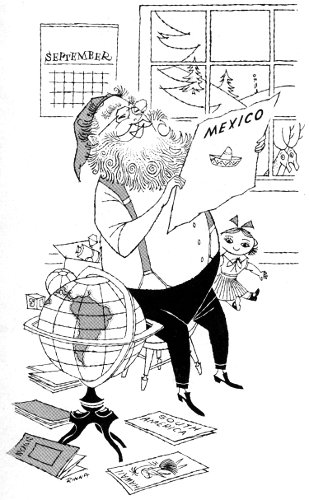
Santa, the jolly gentleman closely identified with fabulous activity during late December, is busy at this time of year, too. He is reputed to circle the globe in a single night at year’s end, all the while busily popping up and down chimneys.
He is able to do all of this because he planned ahead. And if you want Santa to visit you in some foreign land, start your planning now, too. Santa has to plan his trip alone, but you can get the expert help of the Foreign and Domestic Travel Department of the California State Automobile Association.
There is a special tour leaving San Diego December 17, planned so you visit Mexico to celebrate the Nativity during Posada time. Another thrilling experience is to have Santa visit you at sea during a shipboard Christmas party. Sail from San Francisco on December 21 and enjoy the special hospitality of the S.S. Lurline on Christmas day. Or on the South America tour leaving San Francisco on November 13, make the optional return by sea with special entertainment provided on the S.S. Del Sud. For complete holiday travel information mail this coupon:
Foreign and Domestic Travel Department
California State Automobile Association, 150 Van Ness Avenue, San Francisco 2
Please send me information on
[ ] Mexico Tour [ ] Hawaii Tour [ ] South America Tour
Name ________________ Address ________________

Around Monterey Bay
A view of the beach and boardwalk at Santa Cruz, thronged with
bathers and pleasure-seekers. The broad, safe beach and mild
climate have made this a popular fun center for young and old.
End of the Project Gutenberg EBook of Motorland Magazine, September-October,
1955, by Anonymous
*** END OF THIS PROJECT GUTENBERG EBOOK MOTORLAND MAGAZINE ***
***** This file should be named 63005-h.htm or 63005-h.zip *****
This and all associated files of various formats will be found in:
http://www.gutenberg.org/6/3/0/0/63005/
Produced by Stephen Hutcheson and the Online Distributed
Proofreading Team at https://www.pgdp.net
Updated editions will replace the previous one--the old editions
will be renamed.
Creating the works from public domain print editions means that no
one owns a United States copyright in these works, so the Foundation
(and you!) can copy and distribute it in the United States without
permission and without paying copyright royalties. Special rules,
set forth in the General Terms of Use part of this license, apply to
copying and distributing Project Gutenberg-tm electronic works to
protect the PROJECT GUTENBERG-tm concept and trademark. Project
Gutenberg is a registered trademark, and may not be used if you
charge for the eBooks, unless you receive specific permission. If you
do not charge anything for copies of this eBook, complying with the
rules is very easy. You may use this eBook for nearly any purpose
such as creation of derivative works, reports, performances and
research. They may be modified and printed and given away--you may do
practically ANYTHING with public domain eBooks. Redistribution is
subject to the trademark license, especially commercial
redistribution.
*** START: FULL LICENSE ***
THE FULL PROJECT GUTENBERG LICENSE
PLEASE READ THIS BEFORE YOU DISTRIBUTE OR USE THIS WORK
To protect the Project Gutenberg-tm mission of promoting the free
distribution of electronic works, by using or distributing this work
(or any other work associated in any way with the phrase "Project
Gutenberg"), you agree to comply with all the terms of the Full Project
Gutenberg-tm License (available with this file or online at
http://gutenberg.org/license).
Section 1. General Terms of Use and Redistributing Project Gutenberg-tm
electronic works
1.A. By reading or using any part of this Project Gutenberg-tm
electronic work, you indicate that you have read, understand, agree to
and accept all the terms of this license and intellectual property
(trademark/copyright) agreement. If you do not agree to abide by all
the terms of this agreement, you must cease using and return or destroy
all copies of Project Gutenberg-tm electronic works in your possession.
If you paid a fee for obtaining a copy of or access to a Project
Gutenberg-tm electronic work and you do not agree to be bound by the
terms of this agreement, you may obtain a refund from the person or
entity to whom you paid the fee as set forth in paragraph 1.E.8.
1.B. "Project Gutenberg" is a registered trademark. It may only be
used on or associated in any way with an electronic work by people who
agree to be bound by the terms of this agreement. There are a few
things that you can do with most Project Gutenberg-tm electronic works
even without complying with the full terms of this agreement. See
paragraph 1.C below. There are a lot of things you can do with Project
Gutenberg-tm electronic works if you follow the terms of this agreement
and help preserve free future access to Project Gutenberg-tm electronic
works. See paragraph 1.E below.
1.C. The Project Gutenberg Literary Archive Foundation ("the Foundation"
or PGLAF), owns a compilation copyright in the collection of Project
Gutenberg-tm electronic works. Nearly all the individual works in the
collection are in the public domain in the United States. If an
individual work is in the public domain in the United States and you are
located in the United States, we do not claim a right to prevent you from
copying, distributing, performing, displaying or creating derivative
works based on the work as long as all references to Project Gutenberg
are removed. Of course, we hope that you will support the Project
Gutenberg-tm mission of promoting free access to electronic works by
freely sharing Project Gutenberg-tm works in compliance with the terms of
this agreement for keeping the Project Gutenberg-tm name associated with
the work. You can easily comply with the terms of this agreement by
keeping this work in the same format with its attached full Project
Gutenberg-tm License when you share it without charge with others.
1.D. The copyright laws of the place where you are located also govern
what you can do with this work. Copyright laws in most countries are in
a constant state of change. If you are outside the United States, check
the laws of your country in addition to the terms of this agreement
before downloading, copying, displaying, performing, distributing or
creating derivative works based on this work or any other Project
Gutenberg-tm work. The Foundation makes no representations concerning
the copyright status of any work in any country outside the United
States.
1.E. Unless you have removed all references to Project Gutenberg:
1.E.1. The following sentence, with active links to, or other immediate
access to, the full Project Gutenberg-tm License must appear prominently
whenever any copy of a Project Gutenberg-tm work (any work on which the
phrase "Project Gutenberg" appears, or with which the phrase "Project
Gutenberg" is associated) is accessed, displayed, performed, viewed,
copied or distributed:
This eBook is for the use of anyone anywhere at no cost and with
almost no restrictions whatsoever. You may copy it, give it away or
re-use it under the terms of the Project Gutenberg License included
with this eBook or online at www.gutenberg.org/license
1.E.2. If an individual Project Gutenberg-tm electronic work is derived
from the public domain (does not contain a notice indicating that it is
posted with permission of the copyright holder), the work can be copied
and distributed to anyone in the United States without paying any fees
or charges. If you are redistributing or providing access to a work
with the phrase "Project Gutenberg" associated with or appearing on the
work, you must comply either with the requirements of paragraphs 1.E.1
through 1.E.7 or obtain permission for the use of the work and the
Project Gutenberg-tm trademark as set forth in paragraphs 1.E.8 or
1.E.9.
1.E.3. If an individual Project Gutenberg-tm electronic work is posted
with the permission of the copyright holder, your use and distribution
must comply with both paragraphs 1.E.1 through 1.E.7 and any additional
terms imposed by the copyright holder. Additional terms will be linked
to the Project Gutenberg-tm License for all works posted with the
permission of the copyright holder found at the beginning of this work.
1.E.4. Do not unlink or detach or remove the full Project Gutenberg-tm
License terms from this work, or any files containing a part of this
work or any other work associated with Project Gutenberg-tm.
1.E.5. Do not copy, display, perform, distribute or redistribute this
electronic work, or any part of this electronic work, without
prominently displaying the sentence set forth in paragraph 1.E.1 with
active links or immediate access to the full terms of the Project
Gutenberg-tm License.
1.E.6. You may convert to and distribute this work in any binary,
compressed, marked up, nonproprietary or proprietary form, including any
word processing or hypertext form. However, if you provide access to or
distribute copies of a Project Gutenberg-tm work in a format other than
"Plain Vanilla ASCII" or other format used in the official version
posted on the official Project Gutenberg-tm web site (www.gutenberg.org),
you must, at no additional cost, fee or expense to the user, provide a
copy, a means of exporting a copy, or a means of obtaining a copy upon
request, of the work in its original "Plain Vanilla ASCII" or other
form. Any alternate format must include the full Project Gutenberg-tm
License as specified in paragraph 1.E.1.
1.E.7. Do not charge a fee for access to, viewing, displaying,
performing, copying or distributing any Project Gutenberg-tm works
unless you comply with paragraph 1.E.8 or 1.E.9.
1.E.8. You may charge a reasonable fee for copies of or providing
access to or distributing Project Gutenberg-tm electronic works provided
that
- You pay a royalty fee of 20% of the gross profits you derive from
the use of Project Gutenberg-tm works calculated using the method
you already use to calculate your applicable taxes. The fee is
owed to the owner of the Project Gutenberg-tm trademark, but he
has agreed to donate royalties under this paragraph to the
Project Gutenberg Literary Archive Foundation. Royalty payments
must be paid within 60 days following each date on which you
prepare (or are legally required to prepare) your periodic tax
returns. Royalty payments should be clearly marked as such and
sent to the Project Gutenberg Literary Archive Foundation at the
address specified in Section 4, "Information about donations to
the Project Gutenberg Literary Archive Foundation."
- You provide a full refund of any money paid by a user who notifies
you in writing (or by e-mail) within 30 days of receipt that s/he
does not agree to the terms of the full Project Gutenberg-tm
License. You must require such a user to return or
destroy all copies of the works possessed in a physical medium
and discontinue all use of and all access to other copies of
Project Gutenberg-tm works.
- You provide, in accordance with paragraph 1.F.3, a full refund of any
money paid for a work or a replacement copy, if a defect in the
electronic work is discovered and reported to you within 90 days
of receipt of the work.
- You comply with all other terms of this agreement for free
distribution of Project Gutenberg-tm works.
1.E.9. If you wish to charge a fee or distribute a Project Gutenberg-tm
electronic work or group of works on different terms than are set
forth in this agreement, you must obtain permission in writing from
both the Project Gutenberg Literary Archive Foundation and Michael
Hart, the owner of the Project Gutenberg-tm trademark. Contact the
Foundation as set forth in Section 3 below.
1.F.
1.F.1. Project Gutenberg volunteers and employees expend considerable
effort to identify, do copyright research on, transcribe and proofread
public domain works in creating the Project Gutenberg-tm
collection. Despite these efforts, Project Gutenberg-tm electronic
works, and the medium on which they may be stored, may contain
"Defects," such as, but not limited to, incomplete, inaccurate or
corrupt data, transcription errors, a copyright or other intellectual
property infringement, a defective or damaged disk or other medium, a
computer virus, or computer codes that damage or cannot be read by
your equipment.
1.F.2. LIMITED WARRANTY, DISCLAIMER OF DAMAGES - Except for the "Right
of Replacement or Refund" described in paragraph 1.F.3, the Project
Gutenberg Literary Archive Foundation, the owner of the Project
Gutenberg-tm trademark, and any other party distributing a Project
Gutenberg-tm electronic work under this agreement, disclaim all
liability to you for damages, costs and expenses, including legal
fees. YOU AGREE THAT YOU HAVE NO REMEDIES FOR NEGLIGENCE, STRICT
LIABILITY, BREACH OF WARRANTY OR BREACH OF CONTRACT EXCEPT THOSE
PROVIDED IN PARAGRAPH 1.F.3. YOU AGREE THAT THE FOUNDATION, THE
TRADEMARK OWNER, AND ANY DISTRIBUTOR UNDER THIS AGREEMENT WILL NOT BE
LIABLE TO YOU FOR ACTUAL, DIRECT, INDIRECT, CONSEQUENTIAL, PUNITIVE OR
INCIDENTAL DAMAGES EVEN IF YOU GIVE NOTICE OF THE POSSIBILITY OF SUCH
DAMAGE.
1.F.3. LIMITED RIGHT OF REPLACEMENT OR REFUND - If you discover a
defect in this electronic work within 90 days of receiving it, you can
receive a refund of the money (if any) you paid for it by sending a
written explanation to the person you received the work from. If you
received the work on a physical medium, you must return the medium with
your written explanation. The person or entity that provided you with
the defective work may elect to provide a replacement copy in lieu of a
refund. If you received the work electronically, the person or entity
providing it to you may choose to give you a second opportunity to
receive the work electronically in lieu of a refund. If the second copy
is also defective, you may demand a refund in writing without further
opportunities to fix the problem.
1.F.4. Except for the limited right of replacement or refund set forth
in paragraph 1.F.3, this work is provided to you 'AS-IS' WITH NO OTHER
WARRANTIES OF ANY KIND, EXPRESS OR IMPLIED, INCLUDING BUT NOT LIMITED TO
WARRANTIES OF MERCHANTABILITY OR FITNESS FOR ANY PURPOSE.
1.F.5. Some states do not allow disclaimers of certain implied
warranties or the exclusion or limitation of certain types of damages.
If any disclaimer or limitation set forth in this agreement violates the
law of the state applicable to this agreement, the agreement shall be
interpreted to make the maximum disclaimer or limitation permitted by
the applicable state law. The invalidity or unenforceability of any
provision of this agreement shall not void the remaining provisions.
1.F.6. INDEMNITY - You agree to indemnify and hold the Foundation, the
trademark owner, any agent or employee of the Foundation, anyone
providing copies of Project Gutenberg-tm electronic works in accordance
with this agreement, and any volunteers associated with the production,
promotion and distribution of Project Gutenberg-tm electronic works,
harmless from all liability, costs and expenses, including legal fees,
that arise directly or indirectly from any of the following which you do
or cause to occur: (a) distribution of this or any Project Gutenberg-tm
work, (b) alteration, modification, or additions or deletions to any
Project Gutenberg-tm work, and (c) any Defect you cause.
Section 2. Information about the Mission of Project Gutenberg-tm
Project Gutenberg-tm is synonymous with the free distribution of
electronic works in formats readable by the widest variety of computers
including obsolete, old, middle-aged and new computers. It exists
because of the efforts of hundreds of volunteers and donations from
people in all walks of life.
Volunteers and financial support to provide volunteers with the
assistance they need, are critical to reaching Project Gutenberg-tm's
goals and ensuring that the Project Gutenberg-tm collection will
remain freely available for generations to come. In 2001, the Project
Gutenberg Literary Archive Foundation was created to provide a secure
and permanent future for Project Gutenberg-tm and future generations.
To learn more about the Project Gutenberg Literary Archive Foundation
and how your efforts and donations can help, see Sections 3 and 4
and the Foundation web page at http://www.pglaf.org.
Section 3. Information about the Project Gutenberg Literary Archive
Foundation
The Project Gutenberg Literary Archive Foundation is a non profit
501(c)(3) educational corporation organized under the laws of the
state of Mississippi and granted tax exempt status by the Internal
Revenue Service. The Foundation's EIN or federal tax identification
number is 64-6221541. Its 501(c)(3) letter is posted at
http://pglaf.org/fundraising. Contributions to the Project Gutenberg
Literary Archive Foundation are tax deductible to the full extent
permitted by U.S. federal laws and your state's laws.
The Foundation's principal office is located at 4557 Melan Dr. S.
Fairbanks, AK, 99712., but its volunteers and employees are scattered
throughout numerous locations. Its business office is located at
809 North 1500 West, Salt Lake City, UT 84116, (801) 596-1887, email
business@pglaf.org. Email contact links and up to date contact
information can be found at the Foundation's web site and official
page at http://pglaf.org
For additional contact information:
Dr. Gregory B. Newby
Chief Executive and Director
gbnewby@pglaf.org
Section 4. Information about Donations to the Project Gutenberg
Literary Archive Foundation
Project Gutenberg-tm depends upon and cannot survive without wide
spread public support and donations to carry out its mission of
increasing the number of public domain and licensed works that can be
freely distributed in machine readable form accessible by the widest
array of equipment including outdated equipment. Many small donations
($1 to $5,000) are particularly important to maintaining tax exempt
status with the IRS.
The Foundation is committed to complying with the laws regulating
charities and charitable donations in all 50 states of the United
States. Compliance requirements are not uniform and it takes a
considerable effort, much paperwork and many fees to meet and keep up
with these requirements. We do not solicit donations in locations
where we have not received written confirmation of compliance. To
SEND DONATIONS or determine the status of compliance for any
particular state visit http://pglaf.org
While we cannot and do not solicit contributions from states where we
have not met the solicitation requirements, we know of no prohibition
against accepting unsolicited donations from donors in such states who
approach us with offers to donate.
International donations are gratefully accepted, but we cannot make
any statements concerning tax treatment of donations received from
outside the United States. U.S. laws alone swamp our small staff.
Please check the Project Gutenberg Web pages for current donation
methods and addresses. Donations are accepted in a number of other
ways including checks, online payments and credit card donations.
To donate, please visit: http://pglaf.org/donate
Section 5. General Information About Project Gutenberg-tm electronic
works.
Professor Michael S. Hart is the originator of the Project Gutenberg-tm
concept of a library of electronic works that could be freely shared
with anyone. For thirty years, he produced and distributed Project
Gutenberg-tm eBooks with only a loose network of volunteer support.
Project Gutenberg-tm eBooks are often created from several printed
editions, all of which are confirmed as Public Domain in the U.S.
unless a copyright notice is included. Thus, we do not necessarily
keep eBooks in compliance with any particular paper edition.
Most people start at our Web site which has the main PG search facility:
http://www.gutenberg.org
This Web site includes information about Project Gutenberg-tm,
including how to make donations to the Project Gutenberg Literary
Archive Foundation, how to help produce our new eBooks, and how to
subscribe to our email newsletter to hear about new eBooks.